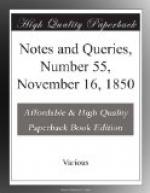“A most faire roode or picture of our Saviour, in silver, called the Black Roode of Scotland, brought out of Holy Rood House, by King David Bruce ... with the picture of Our Lady on the one side of our Saviour, and St. John’s on the other side, very richly wrought in silver, all three having crownes of pure beaten gold of goldsmith’s work, with a device or rest to take them off or on.”
The writer then describes the “fine wainscote work” to which this costly “rood and pictures” were fastened on a pillar at the east end of the southern aisle of the quire. And in a subsequent chapter (p. 21. of Surtees Soc. volume) we have an account of the cross miraculously received by David I. (whom the writer confounds with the King David Bruce captured at the battle of Durham, notwithstanding that his Auntient Memorial professes to be “collected forthe of the best antiquaries"), and in honour of which he founded Holy Rood Abbey in 1128 from which account it clearly appears that this cross was distinct from the Black Rood of Scotland. For the writer, after stating that this miraculous cross had been brought from Holy Rood House by the king, as a “most fortunate relique,” says:
“He lost the said crosse, which was taiken upon him, and many other most wourthie and excellent jewells ... which all weare offred up at the shryne of Saint Cuthbert, together with the Blacke Rude of Scotland (so termed), with Mary and John, maid of silver, being, as yt were, smoked all over, which was placed and sett up most exactlie in the pillar next St. Cuthbert’s shrine,” &c.
In the description written in 1593, as printed, the size of the Black Rood is not mentioned; but in Sanderson’s Antiquities of Durham, in which he follows that description, but with many variations and omissions, he says (p. 22.), in mentioning the Black Rood of Scotland, with the images, as above described,—
“Which rood and pictures were all three very richly wrought in silver, and were all smoked blacke over, {410} being large pictures of a yard or five quarters long, and on every one of their leads a crown of pure beaten gold,” &c.
I have one more (too brief) notice of this famous rood. It occurs in the list of reliques preserved in the Feretory of St. Cuthhert, under the care of the shrine-keeper, which was drawn up in 1383 by Richard de Sedbrok, and is as follows:
“A black crosse, called
the Black Rode of Scotland.”—MS.
Dunelm., B.
ii. 35.
Strange to say, Mr. Raine, in his St. Cuthbert, p. 108., appears to confound the cross brought from Holy Rood House, and in honour of which it was founded, with the Black Rood of Scotland. He was misled, no doubt, by the statement in the passage above extracted from the Ancient Monuments, that this cross was brought out of Holy Rood House.




